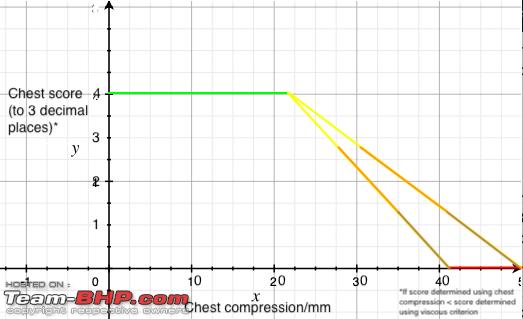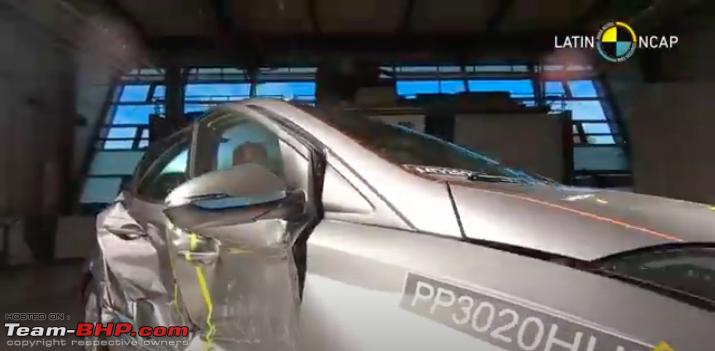Quote:
Originally Posted by fhdowntheline  I just observed from the above list that Datsun Redigo scored better than the Seltos purely from a Points perspective at 23.99 vs 23.03. If certain aspects of the crash impact are interpreted differently for different cars then it should have a correlation between the qualitative ranking (Stars) and the numeric scores. At this point, one interprets that a 3-star Seltos is qualitatively superior to a 1 Star Redigo, although the Redigo has a better numeric score.
I think GNCAP really needs to explain its scoring and ranking system better. |
Note that this is not an official Global NCAP list for ranking. This one seems to be ranked by summing up the total scores for adult and child occupant protection.
Yes the redi-GO and the Kwid with a driver side steering wheel airbag and pretensioners should have scored three stars for adult protection purely based on summation of body region scores as well as application of modifiers, but there exists a 'star cap'.
If a critical body region (head, neck or chest) scores 0.000 points then a 'star cap' is applied.
To sum up the explanation I'll give below (for someone who doesn't want to read the entire thing), the score is capped at 0 stars if a body region scores 0.000 based on biomechanical injury directly, and 1 star if a body region scores 0.000 only after application of 'modifiers'.
For every body region there exists a 'lower performance limit' and a 'higher performance limit' for biomechanical injury readings (parameters used vary by body region). If the injury reading is less than the higher performance limit (which is a lower injury value), then the region is awarded the full 4.000 points (green) initially. If the injury reading is above the lower performance limit (which is a higher injury value) then the region is awarded 0.000 points (red) initially. If the value is between these limits then simple linear interpolation is used to determine the scores. For example, here is a graph I had made for chest compression in different NCAPs some time ago. Here 42mm or 50mm depending on the NCAP is the lower performance limit (worse) and 22mm is the higher performance limit (better).
 Left - Latin NCAP, Euro NCAP etc. and Global NCAP from 2022;
Left - Latin NCAP, Euro NCAP etc. and Global NCAP from 2022;
Right - Global NCAP till mid-2022
For the critical body regions (head, neck, chest) NCAPs also maintain what is known as a 'capping limit' for injury values, that is, the limit beyond which there is a high risk of life-threatening injury (these limits have been recommended by the EEVC, or the European Experimental Vehicles Committee). These limits are also incidentally the same as the maximum permissible injury limits to pass the ECE R94 (or in the case of India, AIS-098) homologation tests, though those are conducted at 56km/h.
Colloquially, capping limits are NCAPs' way of saying the dummy is 'dead', though they won't say this explicitly because they make no attempt to distinguish fatal injury from disabling injury because there are variables involved.
In the case of Global NCAP the capping limits for critical body regions are identical to the respective lower performance limits.
These scores are not the final scores for body regions. The score for each body region may be reduced based on 'modifiers', for example an unstable structure causes reduction of 1.000 point for the chest, footwell rupture causes loss of 1.000 point for the driver feet, and many more. The colours published in the test reports are based on the final scores after application of these 'modifiers'.
The first kind of star cap is the type applied to, for example, the front passenger's neck in the Maruti Suzuki S-Presso. This star cap is applied when the capping limits have directly been crossed based on biomechanical injury readings. In this case the entire ODB test score is reduced to
0.00/16 and since there exists a critical body region that is neither green nor yellow nor orange, the car does not qualify for seatbelt reminder evaluation either. Hence the entire test score is
0.00/17 for adult protection and the result is
zero stars for adult protection.
The second kind of star cap is the type applied to the driver chest in the Renault Kwid (IV) and the Datsun redi-GO. In this case, the score for a critical body region purely based on injury readings is very low but not 0.000, but the score does become 0.000 after modifiers are applied. In this case the star rating for adult occupant protection is
capped at one star regardless of total score, to prevent the car gaining multiple stars. For both cars the driver chest faced the integrity of passenger compartment (unstable structure) modifier which must mean that the biomechanical injury-based score was more than 0.000 but probably less than 1.001.
To sum it up in a very qualitative way that's easier to understand though not entirely factually correct, in a Datsun redi-GO the driver dummy is
very likely dead due to chest injuries but their feet and tibias are very well protected. In the Kia Seltos the driver dummy might sustain foot/tibia injury but they're much more likely to be alive. Do you think it's still fair to give the Datsun redi-GO a three-star rating because of good foot protection?
I hope this helped.
The primary source for the above is Global NCAP's
adult occupant protection assessment protocol which can be found in the 'About' section of their website.
On another, more on-topic note, it doesn't seem to be highlighted on this thread but Global NCAP also tested the XUV700's optional Autonomous Emergency Braking. This was more of an experimental test and not an official test, and there was no protocol used, it was just a consumer test like those used at Stop the Crash's demonstrations. Just static AEB tests using the pedestrian dummies and a vehicle target (not the Global Vehicle Target), and Alejandro Furas (Secretary General of Global NCAP) at the wheel. It's at the end of Car and Bike's video for those interested (timestamp 00:10:06).
Quote:
Originally Posted by Gaur  may be they had a extra test vehicle of the higher spec already used for some other testing and decided to reuse it instead of wasting another usable variant. |
Yes, it was the AEB test for which they purchased an AX7-L variant. And if I have to hazard a guess I think maybe the ESC/pedestrian protection tests too because I don't personally
think they'll let go of the Safer Choice Award. NCAPs do use the pedestrian protection cars for side impact, like the Hyundai HB20 audited by Latin NCAP for side impact, which clearly had the test code of the pedestrian protection tests pasted on it (usually MDxxxxxxxx is for MDB side impact and PPxxxxxxxx is for pedestrian protection, but here PPxxxxxxxx was pasted on the side impact audit test car).

Also, I managed to get the following communication from Mr Alejandro Furas of Global NCAP about common questions people are asking:
Quote:
Side airbags were disabled electronically but with jumpers that trick the electronics
Frontal, I can find out in the documents which engine.
As per our analisys weight difference is insignificant and into the tolerances allowed by Euro NCAP
|
I have asked for further details on the engine type if possible and I will post it here should I get a response.
I've also received confirmation that there will still be more Global NCAP results in 2021 though I'm not 100% sure they're for India (could be South Africa) though there's a high probability they are indeed for India.
 (7)
Thanks
(7)
Thanks
 (4)
Thanks
(4)
Thanks

 (1)
Thanks
(1)
Thanks
 (5)
Thanks
(5)
Thanks
 (3)
Thanks
(3)
Thanks
 (33)
Thanks
(33)
Thanks
 (1)
Thanks
(1)
Thanks
 (3)
Thanks
(3)
Thanks
 (9)
Thanks
(9)
Thanks
 (1)
Thanks
(1)
Thanks
 (1)
Thanks
(1)
Thanks






 If Mr. Rakesh Jhunjhunwala is our own Warren Buffet, I'd say Mr Mahindra is our own Elon Musk!
If Mr. Rakesh Jhunjhunwala is our own Warren Buffet, I'd say Mr Mahindra is our own Elon Musk!



